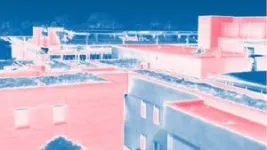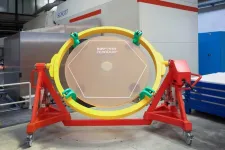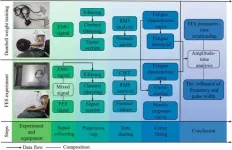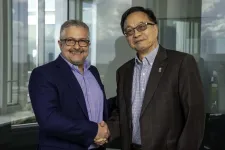(Press-News.org) Researchers at Princeton and UCLA have developed a passive mechanism to cool buildings in the summer and warm them in the winter.
In an article published June 27 in the journal Cell Reports Physical Science, they report that by restricting radiant heat flows between buildings and their environment to specific wavelengths, coatings engineered from common materials can achieve energy savings and thermal comfort that goes beyond what traditional building envelopes can achieve.
“With the increase in global temperatures, maintaining habitable buildings has become a global challenge,” said researcher Jyotirmoy Mandal, an assistant professor of Civil and Environmental Engineering at Princeton. “Buildings exchange a majority of heat with their environment as radiation, and by tailoring the optical properties of their envelopes to exploit how radiation behaves in our environment, we can control heat in buildings in new and impactful ways.”
Radiant heat, carried by electromagnetic waves, is ubiquitous – we feel it when sunlight warms our skin, or when an electric coil heats up a room. Regulating building temperature by controlling radiant heat is a common practice. Most buildings use window shades to block sunlight, and many paint roofs and walls white to reflect the sun.
“If we look at historical cities like Santorini in Greece or Jodhpur in India, we find that cooling buildings by making roofs and walls reflect sunlight has been practiced for centuries,” said researcher Aaswath Raman, an associate professor of Materials Science and Engineering at UCLA. “In recent years there has been massive interest in cool roof coatings that reflect sunlight. But cooling walls and windows is a much more subtle and complex challenge.”
Roofs usually have an open view of the sky. This allows cool roof coatings to reflect sunlight and radiate long-wave heat skywards and eventually to space. Walls and windows, on the other hand, mostly have the ground and neighboring buildings in view. During hot weather, they are warmed by heat radiating from hot streets, pavements and nearby buildings in view. This means that even as walls and windows radiate heat to the sky, they are heated even more by the earth. During cold weather, the terrestrial environment becomes colder, draining heat from walls and windows.
The researchers realized the way around this problem lies in the different way heat moves between buildings and the area at ground level and the way it moves between buildings and the sky. Radiant heat moves from buildings to the sky in a narrow portion of the infrared spectrum known as the atmospheric transmission window, so the researchers call this narrowband. At ground level, radiant heat moves across the entire infrared spectrum, and the researchers call that broadband.
“By coating walls and windows with materials that only radiate or absorb heat in the atmospheric window, we can reduce broadband heat gain from the ground in the summer, and loss in the winter, while maintaining the cooling effect of the sky. We believe that this idea is unprecedented, and beyond what traditional roof and wall envelopes can achieve.” Mandal noted.
The findings’ impact is significant for two important reasons. First, the researchers show in the article that many common and low-cost building materials radiate heat in the narrowband and block broadband heat. Material such as polyvinyl fluoride, already used as siding material, could be adapted for the purpose, as could even more common plastics.
“We were really excited when we found that materials like Polypropylene, which we sourced from household plastics, selectively radiate or absorb heat in the atmospheric window.” Raman noted. “These materials border on the mundane, but the same scalability that makes them common also means that we could see them thermoregulating buildings in the near future.”
The second reason for optimism is that the potential energy impacts at the building scale are substantial. The researchers noted that seasonal energy savings with their mechanism are comparable to the benefits of painting dark roofs white. This could be useful as air conditioning cost and heat related casualties continue to soar worldwide. Mandal and Raman plan to continue this research further.
“The mechanism we proposed is completely passive, which makes it a sustainable way to cool and heat buildings with the seasons and yield untapped energy savings.” Mandal notes. “In fact, the benefits of the mechanisms and materials we show are highest for buildings in the global south. So, it could be a more equitable solution in resource-poor communities, even more as they see increasing cooling demands and heat-related mortalities.”
The article, Radiative Cooling and Thermoregulation in the Earth’s Glow, was published June 27 in the journal Cell Reports Physical Science. Besides Mandal and Raman, the authors include Jyothis Anand, of Oak Ridge National Lab; John Brewer, of UCLA; Sagar Mandal, independent researcher, and Arvind Ramachandran, of Arizona State University. Support for the project was provided in part by the Schmidt Science Fellowship, the Alfred P. Sloan Foundation, and the National Science Foundation.
END
Research shows how common plastics could passively cool and heat buildings with the seasons
2024-06-27
ELSE PRESS RELEASES FROM THIS DATE:
Study supports precision radiation therapy in lung cancer
2024-06-27
HOUSTON ― Results from a new study led by researchers at The University of Texas MD Anderson Cancer Center support standard use of the more precise intensity-modulated radiotherapy (IMRT) over the alternative 3D-conformal radiotherapy (3D-CRT) for patients with unresectable, locally advanced non-small cell lung cancer (NSCLC). The study, published today in JAMA Oncology, revealed fewer side effects with IMRT, with similar survival outcomes.
A prospective secondary analysis of long-term outcomes from 483 patients on the Phase III NRG Oncology-RTOG 0617 randomized trial demonstrated ...
These mushrooms have “massively expanded” genomes to make them more adaptable to multiple lifestyles
2024-06-27
A study of multiple Mycena mushroom species reported in the journal Cell Genomics has found that they have unexpectedly large genomes. While the mushrooms had been thought to be purely saprotrophic – living by degrading dead organic material alone – the discovery suggests that they may instead have a collection of genes to enable them to adapt to different lifestyles as circumstances change. Interestingly, they show certain Mycena strains living in the Arctic have some of the largest mushroom genomes ever described.
These mushrooms show widespread growth across their genome. This includes not only the genes that help them invade or interact ...
AAAS and BII inaugurate new prize recognizing translational achievements in women’s health
2024-06-27
In collaboration with the BioInnovation Institute (BII), AAAS is announcing the establishment of the BII & Science Translational Medicine Prize for Innovations in Women’s Health. Submissions are now open for the first year of the prize, which will be awarded in 2025.
The new award will aim to recognize and elevate scientists who have made outstanding research discoveries that have translational potential to impact women’s health around the world.
Relevant research topics include, but are not limited to, investigation into maternal health and gynecological conditions, areas of ...
$10.5M biomaterials center to connect researchers, fund innovation and fight resource discrimination
2024-06-27
Images
Simultaneously advancing biomaterials research with clinical applications and connecting researchers at well-resourced institutions with those rich in diverse talent is the aim of a $10.5 million center supported by the National Institutes of Health.
The Humanity Unlocking Biomaterials center, led by the University of Michigan and University of Washington, is designed to spur the development of biomaterials solutions that have potential in medical treatments by bringing together researchers and providing seed funding to kickstart ...
Last segment of the world’s largest telescope mirror successfully cast
2024-06-27
The European Southern Observatory’s Extremely Large Telescope (ESO’s ELT), under construction in the Chilean Atacama Desert, is one step closer to completion. German company SCHOTT has successfully cast the blank for the last of the 949 segments commissioned for the telescope’s primary mirror (M1). With a diameter of more than 39 metres, M1 will be by far the largest mirror ever made for a telescope.
Too large to be made from a single piece of glass, M1 will consist of 798 hexagonal segments, each about five centimetres thick and 1.5 ...
Climate change and sea level rise pose an acute challenge for cities with combined sewer systems
2024-06-27
Older coastal cities, like Philadelphia, New York and Boston are at risk of being inundated by untreated sewage during floods. Due in part to the design of their combined sewer systems and in part due to sea level rise, these cities could be facing a growing public health crisis as climate change also drives more extreme precipitation, according to researchers at Drexel University who study urban stormwater management. The group recently published research that modeled the potential extent of the problem in a section of the coastal city of Camden, New Jersey, and the effectiveness of one proposed intervention to help ...
Revolutionary study finds optimal FES settings for enhancing muscle recovery training
2024-06-27
At present, stroke has become one of the most serious neurological diseases, which is usually accompanied by movement disorders and cognitive impairment. In recent years, the number of stroke patients has increased annually . Most stroke patients are accompanied by movement disorders, which seriously affect the normal life of patients. A groundbreaking study conducted by Shihao Sun and colleagues, recently published in the Cyborg Bionic Systems journal, has introduced innovative findings in the realm of Functional Electrical Stimulation (FES), particularly its application in muscle recovery and fatigue management.
Functional ...
MD Anderson and Rice launch Cancer Bioengineering Collaborative
2024-06-27
HOUSTON ― The University of Texas MD Anderson Cancer Center and Rice University today announced the creation of the Cancer Bioengineering Collaborative to develop innovative technologies and bioengineering approaches to improve cancer research, diagnosis and treatment.
Led by Rice’s Gang Bao, Ph.D., and MD Anderson’s Jeffrey Molldrem, M.D., the initiative aims to foster collaboration between the two institutions on fundamental and translational cancer research, to develop new technologies for cancer detection and therapy, and to secure external funding in support of further research and training.
Envisioned as a hub for accelerating ...
Harnessing musculoskeletal modeling: A leap forward in personalized muscle strength assessment
2024-06-27
Researchers have developed an innovative method for assessing spinal muscle strength, utilizing isokinetic testing combined with advanced spine musculoskeletal modeling. This cutting-edge approach, detailed in a study published by the Cyborg and Bionic Systems journal, marks a significant advancement in personalized health and athletic training.
Understanding individual muscle strength is crucial for optimizing physical therapy and enhancing athletic performance. Traditional methods, however, often fall short in precision. The newly introduced technique by Zuming Xiao and colleagues from the Beijing Institute of Technology and Shenyang ...
MIT Press journals earn high impact factors in 2023, with notable strength in linguistics
2024-06-27
We are pleased to share that many MIT Press journals were ranked highly in their fields in 2023, earning exceptional impact factors—which measure recent citation activity for scholarship—and placing in the top quartile of all journals for their areas of study.
Several MIT Press journals in linguistics landed in the top of the field—including Transactions of the Association for Computational Linguistics at #6 out of all 297 linguistics journals in publication; Computational Linguistics at #10; Neurobiology of Language at #14; and Linguistic Inquiry at #77. We ...







